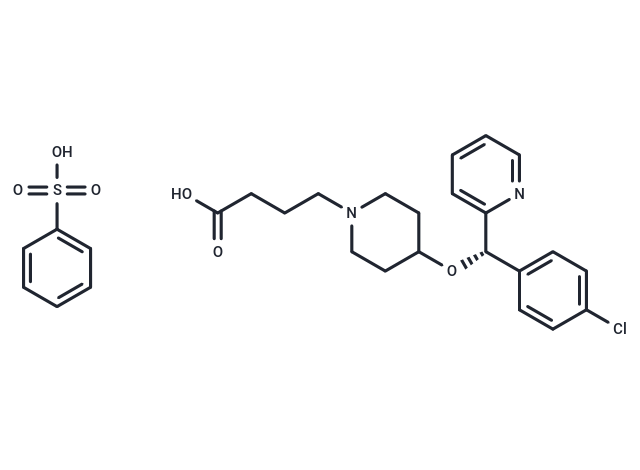Shopping Cart
- Remove All
 Your shopping cart is currently empty
Your shopping cart is currently empty


| Pack Size | Price | Availability | Quantity |
|---|---|---|---|
| 100 mg | $39 | In Stock | |
| 500 mg | $91 | In Stock | |
| 1 mL x 10 mM (in DMSO) | $29 | In Stock |
| Description | Bepotastine Besilate (TAU 284) is a non-sedating and selective H1 receptor antagonist (pIC50: 5.7). |
| Targets&IC50 | H1 receptor:5.7(pIC50) |
| In vitro | The flux ratios of [14C]Bepotastine (5 μM) in LLC-GA5-COL150 cells are significantly greater than those in LLC-PK1, showing that the B-to-A flux exceeds those in the other direction in LLC-GA5-COL150 cells. Bepotastine stimulates P-gp-mediated ATP hydrolysis with Km, Vmax, and Vmax/Km values of 1.25 mM, 108 nmol/min/mg protein, and 0.087 mL/min/mg protein, respectively. [2] Bepotastine besilate (100 mM) suppresses Leukotriene B(4) induced Ca(2+) concentration in cultured dorsal root ganglion neurons and cultured neutrophils. [3] Bepotastine (100 μM) dose-dependently inhibits chemotaxis of cultured guinea pig peritoneal eosinophils induced by LTB4. Bepotastine (1 mM) significantly reduces A23187-induced histamine release of cultured rat peritoneal mast cells. [4] |
| In vivo | Bepotastine (0.8 mg/kg) administrated in WT and P-gp KO mice results in the plasma total concentrations 580 ng/mL and 467 ng/mL at 6 min after dosing, respectively, and the plasma protein binding with 41.1% and 45.9%. The absorption of [14C]Bepotastine from the proximal region in the presence and absence of verapamil is 63.0% and 72.4%, respectively, and that from the distal region is 10.9% and 62.7%, respectively. [2] Bepotastine besilate (10 mg/kg) inhibits scratching induced by an intradermal injection of histamine (100 nmol/site), but not serotonin (100 nmol/site). Bepotastine besilate (1 mg/kg-10 mg/kg, oral) dose-dependently suppresses scratching induced by substance P (100 nmol/site) and leukotriene B(4) (0.03 nmol/site). [3] Bepotastine besilate significantly inhibits conjunctival vascular hyperpermeability in a dose-dependent manner in guinea pig allergic conjunctivitis models with maximal effect for Bepotastine besilate 1.5%. [4] Bepotastine (3 mg/kg and 10 mg/kg) effectively inhibits the compound 48/80-induced scratching behavior of BALB/c mice 1 hour after oral administration. Bepotastine (10 mg/kg) also significantly inhibits the scratching behavior and suppresses the serum LTB(4) levels in atopic dermatitis model NC/Nga mice. [5] |
| Kinase Assay | Isothermal Titration Calorimetry (ITC) of Nucelotide Binding: The titration experiments are performed using the MSC system. In each experiment, 16 aliquots of 15 μL of geldanamycin (300 μM in 1% DMSO) are injected into 1.3 mL of protein (31 μM in 20 mMTris-HCl, pH 7.5, 1 mMEDTA) at 25 °C, and the resulting data are fit after subtracting the heats of dilution. Heats of dilution are determined in separate experiments from addition of geldanamycin into buffer and buffer into protein. No evidence for binding of DMSO in the nucleotide binding site is observed. Titration data are fit using a nonlinear least-squares curve-fitting algorithm with three floating variables: stoichiometry, binding constant (Kb) 1/Kd), and change of enthalpy of interaction (ΔH°). Dissociation constants estimated for geldanamycin binding to intact yeast Hsp90 is 1.22 μM, and for binding to Hsp90 N-terminal domain is 0.78 μM. No meaningful heat is observed with binding to the C-terminal fragment. |
| Alias | Talion, TAU 284, Bepreve, Bepotastine Beslilate |
| Molecular Weight | 547.06 |
| Formula | C21H25ClN2O3·C6H6O3S |
| Cas No. | 190786-44-8 |
| Storage | Powder: -20°C for 3 years | In solvent: -80°C for 1 year | Shipping with blue ice. | |||||||||||||||||||||||||||||||||||
| Solubility Information | DMSO: 101 mg/mL (184.6 mM) Ethanol: < 1 mg/mL (insoluble or slightly soluble) H2O: < 1 mg/mL (insoluble or slightly soluble) | |||||||||||||||||||||||||||||||||||
Solution Preparation Table | ||||||||||||||||||||||||||||||||||||
DMSO
| ||||||||||||||||||||||||||||||||||||

Copyright © 2015-2024 TargetMol Chemicals Inc. All Rights Reserved.